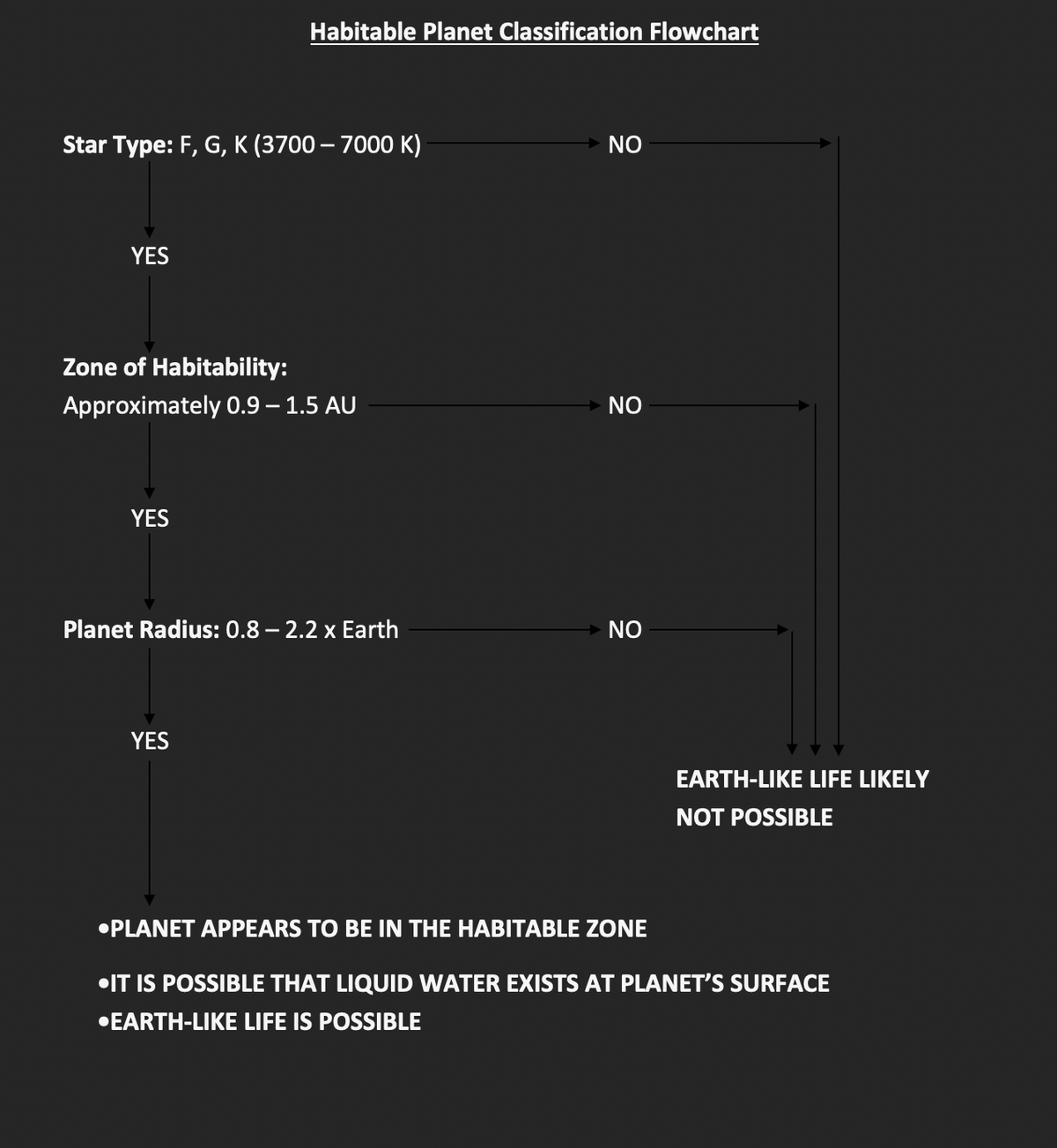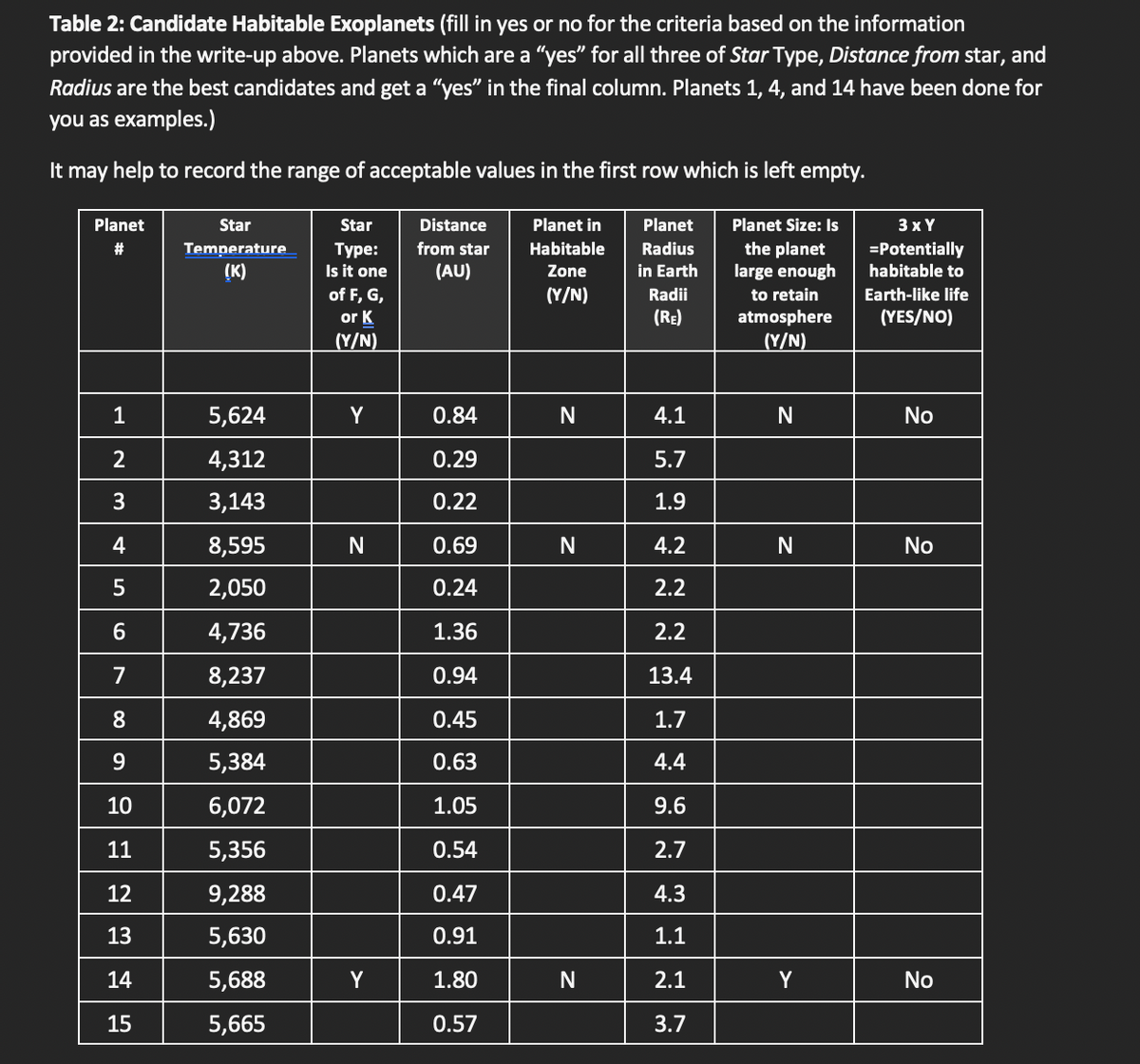In Table 2, there is a list of 15 planets, some of which are real objects discovered by the Kepler space telescope, and some are hypothetical planets. For each one, you are provided the temperature of the star that each planet orbits in degrees Kelvin (K), the distance that each planet orbits from their star in astronomical units (AUs) and the size or radius of each planet in Earth radii (RE). Since we are concerned with finding Earth-like planets, we will assume that the composition of these planets are similar to Earth's, so we will not directly look at their masses, rather their sizes (radii) along with the other characteristics. Determine which of these 15 planets meets our criteria of a planet that could possibly support Earth-like life. Use the Habitable Planet Classification Flow Chart (below) to complete Table 2. Whenever the individual value you are looking at falls within the range of values specified on the flow chart, mark the cell to the right of the value with a Y for yes. For values that do not fall within the specified range mark the cell to the right of it with and N for no. Repeat this procedure for each planet. If all three values fall within the specified ranges (the answer to each step in the flow chart is yes), mark the very last column with a YES. If all three values do not fall within the specified range, mark the last column with a NO.
In Table 2, there is a list of 15 planets, some of which are real objects discovered by the Kepler space telescope, and some are hypothetical planets. For each one, you are provided the temperature of the star that each planet orbits in degrees Kelvin (K), the distance that each planet orbits from their star in astronomical units (AUs) and the size or radius of each planet in Earth radii (RE). Since we are concerned with finding Earth-like planets, we will assume that the composition of these planets are similar to Earth's, so we will not directly look at their masses, rather their sizes (radii) along with the other characteristics. Determine which of these 15 planets meets our criteria of a planet that could possibly support Earth-like life.
Use the Habitable Planet Classification Flow Chart (below) to complete Table 2. Whenever the individual value you are looking at falls within the range of values specified on the flow chart, mark the cell to the right of the value with a Y for yes. For values that do not fall within the specified range mark the cell to the right of it with and N for no. Repeat this procedure for each planet. If all three values fall within the specified ranges (the answer to each step in the flow chart is yes), mark the very last column with a YES. If all three values do not fall within the specified range, mark the last column with a NO.
Questions 9
Tasks to complete:
1. Fill out Table 2, using the Habitable Planet Classification Chart once Table 2 is completely filled in, answer the questions 9 . To fill in the table:
For Star Type, you will need to reference the star temperatures addressed in the write-up above. If the star temperature of the planet is within the range of an F, G, or K type star, it gets a “Yes” in that column.
For Planet Habitable Zone, you will need to reference the Orbital Distance (Habitable Zone) write-up above and answer yes or no for each planet.
For Planet Size, you will assign a yes to planets with radii large enough to retain atmospheres. This is accomplished comparing the planet’s radius in Earth radii (provided in the table) to the range stated in the section above, Planetary Mass and Size.
Planets which have yes to all three columns are potentially habitable to Earth-like life and so they get a “yes” in the final column.
COULD FILL THE TABLE ATTACHED BELOW FIRST THEN PROVIDE AN ANSWER TO QUESTION 9.
Question 9:
In table 2, which planets in the table are Potentially Habitable to Earth-like Life?


Step by step
Solved in 2 steps with 1 images









